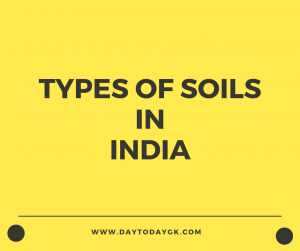DayTodayGK has prepared a detailed post on Types of Soils in India. This is one of the important topics in Static GK. Read it clearly and also share with your Friends.
What is meant by Soil?
The soil is one of the major natural resources, like air and water. It is the topmost layer of the earth’s crust and is a mixture of finely powdered rocks, organic matter, liquids, myriad organisms and other minerals. It acts as an interface between hydrosphere, lithosphere, earth’s atmosphere and biosphere.
What determines the Soil?
The proportion of the key ingredients determines the type of soil. But, factors such as vegetation, climatic conditions, human activities for e.g. grazing, farming, gardening etc also influence soil formation. In India, various types of soils are found and their formations are influenced by certain factors such as altitude, climate disproportionate rainfall and many others. The type of soil differs in different areas of the country.

Classification of Soils
Soils in India has been Classified into eight Groups by Indian Council Of Agricultural Research (ICAR)
- Alluvial Soil
- Black Soil
- Red Soil
- Laterite Soil
- Mountain Soils
- Desert Soils
- Saline Soils
- Peaty or Organic Soils
1) Alluvial Soil:
Alluvial soils cover 24% of the land surface in India and are found in Indo Ganga – Brahmaputra plain, coastal plains and river valleys. These are also found in foothills regions in plenty. It contains sand, loam and clay in different proportion.
there are two types of alluvial soils:
• Khadar – which are newer alluvium. it is the soil deposited by the rivers every year. It is more fertile than the Bangar.
• Bangar -the older alluvium is composed of lime nodules and has clayey composition. It is dark in color.
Distribution: Ganga and Brahmaputra river valleys; deltas of Godavari and Krishna; plains of Uttar Pradesh, Uttaranchal, Punjab, Haryana, West Bengal and Bihar; Coastal strip of peninsular India.
Predominant crops :
Rice, Wheat, Sugarcane, oilseeds
2) Black Soil:
The black soils are also called regur (from the Telugu word Reguda) and black cotton soils because cotton is the most important crop grown on these soils. Several theories have been put forward regarding the origin of this group of soils but most pedologists believe that these soils have been formed due to the solidification of lava spread over large areas during volcanic activity in the Deccan Plateau, thousands of years ago.
These soils are rich in iron, magnesium and aluminum compounds, but poor in lime, humus, nitrogen and phosphoric acid.
Distribution:
Maharashtra and Malwa plateaus , Kathiawar peninsula, Telengana and Rayalasema region of Andhra and northern part of Karnataka.
Predominant crops :
Cotton, millets(include Jowar, Bajra and ragi ), tobacco, sugarcane.
3) Red Soils:
This type of soil is formed as a result of weathering of metamorphic and igneous rocks. The red colour of the soil comes from the high percentage of iron content. The soil’s texture varies from being sandy to clayey, but it is mainly loamy. It is rich in potash content but lacks phosphate, humus and nitrogen content.
These soils are rich in iron, magnesium and aluminum compounds, but poor in lime, humus, nitrogen and phosphoric acid.
Distribution:
Tamil Nadu, Madhya Pradesh, Jharkhand, Odisha, some parts of Karnataka and southeast Maharashtra.
4) Laterite Soils:
• These are residual in nature which is formed under typical monsoonal conditions. The process of formation is called leaching. In leaching process, siliceous compounds of soil are washed away by heavy rain in a hot climate and sloppy terrain, hence such soils are deficient in siliceous compounds.
• These soils are not very fertile but proved to be suitable for bushes and pastures only. With the help of fertilizers, this soil can be made suitable for the cultivation of plantation crops such as coffee, coconut, cashew nut, ragi etc.
Distribution:
Assam hills, hill of summits of Kerala and Karnataka and Eastern Ghats region of Orissa.
Predominant crops :
Coffee, rubber, cashew nut, tapioca
5) Mountain soil:
Mountain soils are formed due to the accumulation of organic matter which is derived from the forest growth. This type of soil is rich in humus but has poor lime, potash and phosphorus content. It is generally sandy and has gravels. It is mainly found in the Himalayan region of the country. Maize, barley, wheat and temperate fruits are grown in this soil in the Himalayan region.
These are acidic in nature due to the excessive presence of less decomposed humus. These soils require fertilizers for agricultural purposes.
Distribution:
Coniferous forest belt of Jammu and Kashmir, Himachal Pradesh, Uttaranchal and Sikkim.
6) Desert Soils:
The desert soil is found in regions with low rainfall. The sand in the desert areas is partly original and partly blown from Indus Valley. The soil content has 90-95% of sand and 5-10% of clay. The phosphate content in the soil is high while the nitrogen content is low.
The water content in the soil is fulfilled through irrigation. This type of soil is found in arid and semi-arid areas.
Contain a high percentage of soluble salts but are poor in organic matter; rich enough in phosphate though poor in nitrogen.
Distribution:
Rajasthan, Northern Gujarat and southern Punjab.
Predominant crops :
Wheat, grams, melon, bajra (with irrigation)
7) Peaty and Marshy Soils:
• These soils are formed due to the accumulation of plenty of organic matters under water-logged conditions for long periods. These are mainly found in coastal areas like Orissa, West Bengal, Tamil Nadu and Kerala in various patches. n Kerala. such soils are also called as Kari.
• These soils are highly saline and deficient in phosphate and potash. so, this soil is useless for agriculture. The colour of marshy soils is dark grey or black due to the presence of organic matter.
Most Trending Topics:
















